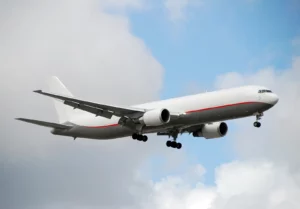
Air freight rates stay firm – while markets fret about elections, Trump, tariffs and trade
Global air freight rates maintained a firm tone again throughout the month of June according the latest data from TAC Index, the leading price reporting agency (PRA) for air freight. The overall Baltic Air Freight Index (BAI00) calculated by TAC ended the four weeks to 1 July down only a tad by -1.2%, leaving it ahead +10.4% over 12 months. The latest data confirms the market has remained surprisingly strong through what is normally a low season in the year – as extra bellyhold capacity comes on stream when passenger traffic increases in the summer. Sources said the relative strength of the market reflects continuing robust activity in e-commerce driven by big China-based exporters such as Temu and Shein. And also continued disruption to ocean shipping – which has been made much more expensive by ships diverting away from the Red Sea and around the Cape of Good Hope. A huge rise in ocean shipping rates has made air cargo look relatively less expensive. These trends are confirmed by TAC’s data on air freight rates out of China, with the index of outbound routes from Hong Kong (BAI30) gaining a further +2.3% in June to put it ahead +21.1% YoY. Outbound Shanghai (BAI80) was slightly lower by -2.7% MoM, but still ahead by a remarkable +42.1% YoY. Rates are also significantly higher YoY out of some other big markets in Asia, notably from India and Vietnam according to TAC data – particularly on lanes to Europe. Out of Europe, by contrast, the market remains somewhat weaker. The index of outbound routes from Frankfurt (BAI20) was lower again by -3.4% MoM, leaving it at -18.3% YoY. Outbound London Heathrow (BAI40) did enjoy a rise in the final week of June to push it ahead by +6.4% MoM, but is still down by -27.2% YoY. From the Americas, the market also ended the month on a weaker note – with a big drop in the final week leaving the often volatile index of outbound routes from Chicago (BAI50) down -15.9% MoM and -32.0% YoY. Nevertheless, the overall tone of the market clearly remains very firm for the time of year – with some reports even proclaiming peak season had come early. Such reports seem somewhat premature – given that traditional peak season is still months away. That said, sources report a lot of block space agreement (BSA) capacity has already been signed up for Thanksgiving and Christmas – which could presage a big spike in spot rates later in the year. Despite the strength of overall demand in the market, there has also been some news of a further tightening of capacity – with FedEx confirming in late June the permanent retirement of some 22 older Boeing 757-200 freighter aircraft from its fleet. In part, this reflects some changes in the structure of the market, including FedEx losing its position as primary cargo provider for the US Postal Service – with that role switching to UPS from September. Some sources suggest it also reflects a reduction in premium rate ‘express’ business – in a market now driven more by e-commerce players moving large volumes of lower value items. Looking ahead, some players are also speculating that e-commerce players could drive demand up for more short-haul narrowbody freighters – if they ship more items initially by ocean to air cargo distribution centres in locations like Mexico and Canada nearer to end-destination markets in North America and Europe. As noted last month, the macroeconomic outlook has also started to look somewhat more optimistic – with the US economy slowing down but at a very gentle rate, and the Federal Reserve looking to engineer an ‘immaculate soft landing’; Europe starting to revive after the shock of the Ukraine war; and Japan enjoying robust growth after years of stagnation. With the economic outlook not too bad, markets have started to fret instead about the political outlook – given the many elections around the world occurring this year, alongside ongoing conflicts in Ukraine and the Middle East. Markets seem relatively sanguine about the prospect of a Labour government in the UK. But traders and investors were rather more spooked by the unexpected snap election in France called by President Macron – which seems likely to result at best in an awkward period of ‘cohabitation’ with a National Assembly no longer aligned with the President. Likewise, there was a surprise when Narendra Modi did not achieve the big majority expected in India, though the result there has not knocked markets so much off course as initial reactions suggested. The big elephant in the room continues to be the US election in November – with increasing concerns about President Biden’s fitness for the task and prospects of a return to power for ex-President Trump. That leaves some fretting about all sorts of potential consequences from the future of democracy in the US to the stability and coherence of the NATO alliance and the wider western rules-based world order. Given Trump’s stance as a populist and previous record in power, one significant worry has been the prospect of more and higher tariffs – aimed at China in particular – and effects on global trade and economic growth. The economies of the US and China – the two biggest in the world – seem so hugely and intricately entwined that further impediments to trade may seem unlikely acts of self-harm for either side to make. That said, as we noted before some months ago, Biden and the Democrats have also proved pretty hawkish in practice on trade issues – not only not reducing or removing tariffs introduced by Trump, but continuing to add to them. Whatever the result in November, it may not be so great for trade and growth.









